Abstract
The decarburization behaviour during the sintering of metal-injection-moulded 420 stainless steel was investigated. Particular attention has been paid to the decarburization mechanisms and carbon distribution of parts sintered at different temperatures. The results indicate that the loss of carbon content occurs mainly through the reduction of surface oxides of powder particles or reaction with the atmosphere. Depending on the densification level, the sintering decarburization is separated into two stages. Below 1200 °C, decarburization occurs at the powder particle surface. The surface oxides react with the amorphous carbon or residual organics to pose the metal surface. At this time, the carbon content distribution of the sintered body is similar to that of the as-debound sample. The reduction of surface oxides promotes sintering. At 1200 °C, the densification speed is higher in the centre region of the sample, where the interconnected pores close and the second stage of decarburization takes place. At temperatures above 1200 °C, carbon atoms in the inner layers must migrate to the surface to react with the atmosphere. The decarburization speed is reduced and the carbon content distribution of the as-sintered part is similar to that of the dense decarburized part.
1. Introduction
Metal injection moulding (MIM) is a novel net shape method for producing stainless steel parts with high performance and complex shapes [1,2]. In the MIM process, metal powder is mixed with a polymer binder to yield the feedstock, which is then injected into a mould with the required shape. The green parts are thermally debound and sintered to remove the binder and obtain nearly full density, respectively. During the thermal process, the carbon content may deviate from the standard composition, which is attributed to the decomposition of the residual organic and chemical reaction of carbon with the oxygen in the metal and atmosphere [3,4].
The decarburization of MIM-produced parts with a porous structure is a rather more complex process than that of the dense parts [5,6,7,8]. The principal complicating factors are the residual decomposed binder composition and various densification stages. After the debinding process, the particles’ surface is always affiliated with the residual organics or graphite, especially in the sample surface regions; therefore, the surface exhibits a higher carbon content than the inner region. These compositions react with the oxygen or moisture in the atmosphere and then escape through pores. Subsequent sintering closes the open pores and affects the decarburization rate; such changes may result in extremely complex densification and decarburization behaviour. Furthermore, the final parts always exhibit an inhomogeneous carbon distribution because of the carbon diffusion. This phenomenon is more obvious in thicker parts or parts with a complex shape. In general, the objective in stainless steelmaking operation is to obtain a desired carbon endpoint [9]. However, in the monitoring of sintering, special attention should be paid to the carbon distribution.
The heterogenous carbon content, especially in large scale, leads to unstable density and mechanical properties [10,11]. The densification rate is significantly influenced by the excess carbon content [12]. Carbon plays a reductant role in sintering; the surface oxides can be reduced, and hence the growth of sintering necking is much easier. Moreover, a higher carbon content can cause liquid-phase generation at relatively low temperatures. However, grain growth is also notable in stainless steel with additional carbon content. At the same time, a lack or excess of carbon causes the stainless steel microstructure to deviate from the standard, and in turn leads to unexpected mechanical properties [13]. The 420 stainless steel is a ferrite/martensite stainless steel that requires extremely accurate carbon control [14]. Proper carbon content could enlarge the sintering temperature range (within the γ + MC + L phase); thus, a sample with a high density and low grain size could be obtained. In order to overcome the drawbacks of heterogenous carbon content, a further understanding on the decarburization mechanism under different temperature ranges is required. The effects of the densification level should be taken into consideration.
The decarburization behaviour of 420 stainless steel was investigated in this work. The decarburization mechanism under different temperatures and the carbon distribution in the sintered parts were analysed. On the basis of the experimental work, theoretical models were proposed to disclose the effects of sintering temperatures on the decarburization rate and carbon distribution. Moreover, the relationship between the decarburization and densification was discussed. The findings of this work could provide a theoretical base for the large-scale production of MIM stainless steel.
2. Experimental Procedures
Gas-atomised 420 stainless steel powder (D50 = 13.41 μm; Hunan Hengji Powder Technology Co., Ltd., Yueyang, China) was used in the experiment. The composition of the 420 powder is shown in Table 1, and the morphology of the powder is shown in Figure 1. The powders were mixed with a paraffin wax-based binder system with a total powder loading of 58% in a rubber mixer at 150 °C for 120 min. The feedstock was injected into a cylinder mould of Ø 6 mm × 8 mm. A two-step debinding method of solvent debonding and thermal debinding was used to remove the binder. The green parts were solvent-debound at 40 °C for 120 min in methylene chloride, followed by thermal debinding and pre-sintering at 900 °C for 60 min in argon gas. Then, the samples were sintered at different temperatures for 2 h under the protection of argon gas.

Table 1.
Chemical composition of gas-atomised 420 stainless steel powder.
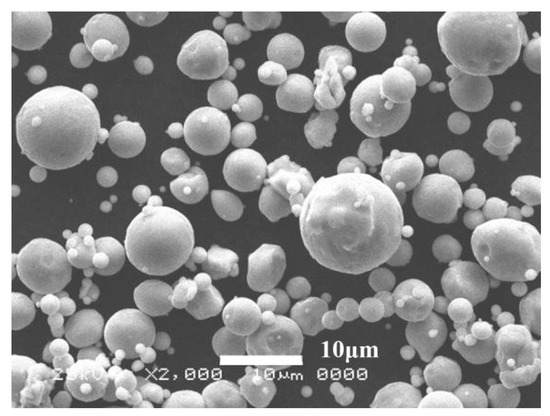
Figure 1.
Scanning electron microscopy (SEM) image of gas atomized 420 stainless steel powder.
The microstructures of the sintered samples were observed with a Leica DM2700M optical microscope (Leica Microystems, Weztlar, Germany), and scanning electron microscopy (SEM) (JSM-6360, JEOL, Tokyo, Japan) was performed to observe the microstructure of the samples. The micro-hardness of the samples was measured by a micro-hardness tester (MicroMet-5140, BUEHLER, Lake Bluff, IL, USA). A carbon–sulfur analyser (TCH-600, LECO, St.Joseph, MI, USA) was used to measure the carbon content of the sintered samples. The oxygen content was tested by an oxygen–nitrogen analyser (TC-436, LECO, St.Joseph, MI, USA). At least three samples were tested to obtain the mean value. In order to test the carbon content of different regions, as-sintered samples were turned. As shown in Figure 2, the thickness of each region was approximately 1 mm; the thickness of region 1 may be slightly higher than 1 mm for samples with a low density. The turning shavings from each region were collected to test the carbon content.
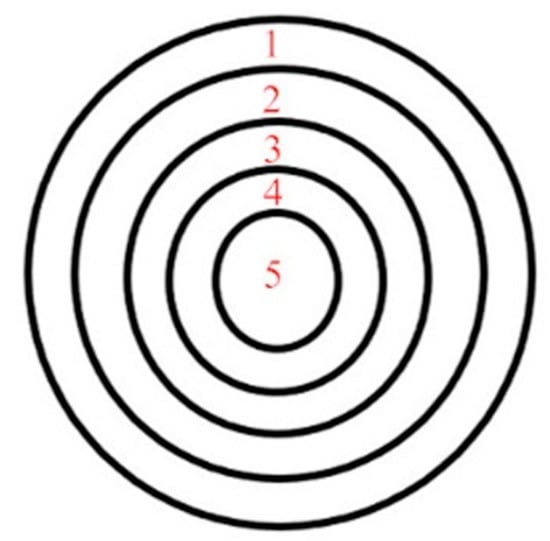
Figure 2.
Schematic diagram of the turning of different regions.
3. Results
3.1. Overall Carbon and Oxygen Content
Figure 3 shows the oxygen and carbon content of samples sintered at different temperatures. Note that the as-debound sample is represented at 900 °C. As shown in Figure 3, the oxygen content increases from 0.18 wt.% at 900 °C to 0.283 wt.% at 1100 °C, after which it sharply decreases to 0.08 wt.% at 1200 °C, and then to near zero above 1300 °C. During this process, the carbon content deceases. It drops from 0.38 wt.% at 900 °C to 0.28 wt.% at 1100 °C. The most significant drop occurs between 1100 and 1200 °C, and then the dropping rate decreases.
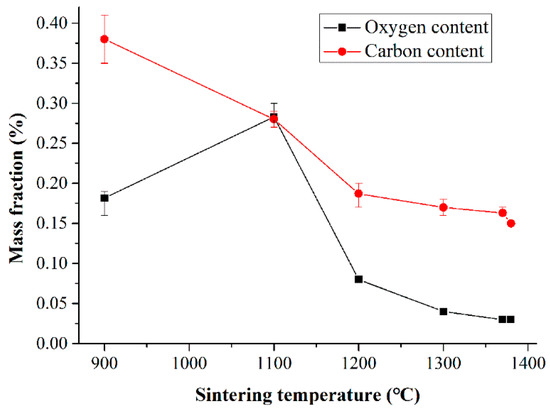
Figure 3.
Oxygen and carbon content of metal injection moulding (MIM)-produced 420 stainless steel samples sintered at different temperatures.
3.2. Carbon Content Distribution
Figure 4 shows the carbon content distribution of samples sintered at different temperatures. Over-burning takes place at 1380 °C; thus, the carbon content distribution test was carried out on samples sintered at temperatures no higher than 1370 °C. In order to verify the repeatability of the experiment, three groups of samples were tested, and the other two groups showed the similar tendency. As the sintering temperature increases, the carbon content decreases for almost all conditions. The surface regions show a higher decarburization rate than the inner area. Below 1200 °C, the surface regions are associated with a higher carbon content and the inner regions show almost equivalent carbon content, which is the typical characteristic of an as-debound part. Above 1300 °C, the inner regions show a higher carbon content. However, in the sample sintered at 1300 °C, regions 3–5 show almost equivalent content. Moreover, regions 3–5 of the sample sintered at 1300 °C show a similar carbon content to those sintered at 1200 °C. In the sample sintered at 1370 °C, the carbon content linearly decreases from region 5 to region 1, which is similar to the decarburization behaviour of the dense parts [7].
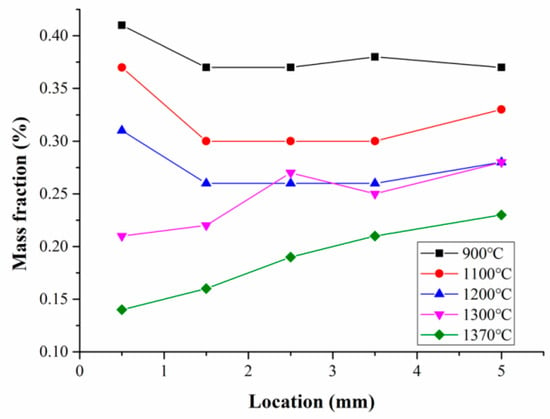
Figure 4.
Distribution of the carbon content in different regions of MIM-produced 420 stainless steel samples sintered at different temperatures.
3.3. Microstructure
The microstructures of the samples sintered at different temperatures are shown in Figure 5. At 1100 °C, very high porosity is observed in Figure 5a. Most pores are open pores and original particles can be distinguished in Figure 5b. From the previous research on Fe-Cr systems [15], the growth of the sintering neck is not obvious at 1100 °C, and the reaction between carbon and oxygen is too weak to remove the oxygen. At 1200 °C, the porosity decreases rapidly, and the centre layer and outer layer exhibit different densities. Obvious sintering has taken place in the centre regions. As shown in Figure 5d, the inner regions show no interconnected pores and the bonding between different particles is quite strong. Some large pores are still observed, but they are isolated. By contrast, in the outer layer, sintering necking and interconnected pores are observed, which means the densification is still in the early stage. At 1300 °C, a much higher density is received and the combination of large pores could be observed both in the centre and outer layer. At 1370 °C, most big pores are eliminated. As shown in Figure 5h, the microhardness test shows that the hardness increases with the distance from the surface, which is similar to the decarburization behaviour of the dense parts.
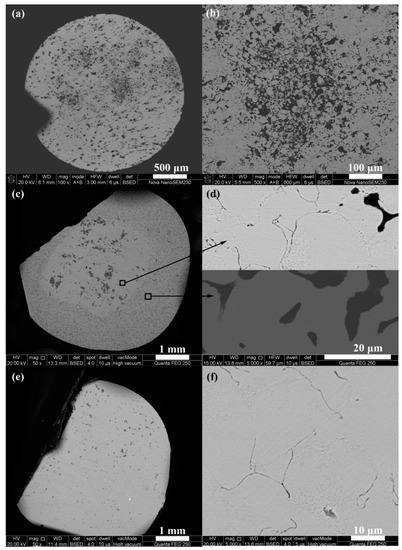
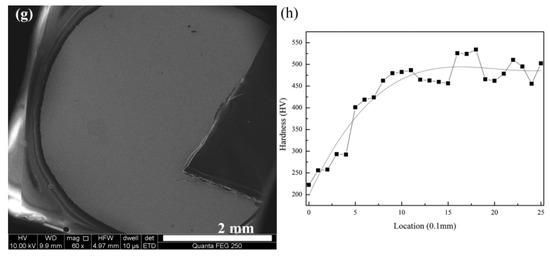
Figure 5.
Scanning electron micrographs of MIM-produced 420 stainless steel samples sintered at different temperatures: (a) and (b) 1100 °C, (c) and (d) 1200 °C, (e) and (f) 1300 °C, and (g) 1370 °C. (h) Microhardness vs. distance to the surface area.
4. Discussion
4.1. Effect of Sintering Temperature on the Decarburization Rate
As shown in Figure 3, decarburization occurs during the entire sintering stage; the most significant range is between 1100 and 1200 °C. When the sample is exposed to the sintering atmosphere and there are many interconnected pores in the sample, the decarburization rate should obey the following equation of interfacial reaction [16]:
where α is the decarburization speed, k is the apparent rate constant, and t is the sintering time. Figure 6 shows the relationship between the calculated ln k and sintering temperature for the sample and different regions. Figure 6a shows that there is no linear relationship between ln k and T−1. From Figure 6b, there is a linear relationship between ln k and T−1 for regions 1 and 2, which are near the surface. The centre regions exhibit no linear relationship. From the data of k, the activation energy can be calculated from the Arrhenius equation:
where E is the apparent activation energy of the decarburization reaction, R is the gas constant, and A is the pre-factor. From the calculation, E of region 1 is 155.9 kJ/mol (R2 = 0.997). Thus, the decarburization behaviour of the surface region is a bit lower, but similar to the decarburization of pure Fe-Cr powder (164 kJ/mol) [17]. E of region 2 is 50.3 kJ/mol (R2 = 0.967), which means the decarburization speed is difficult to accelerate; this can be attributed to the limited exposed metal area from the interconnected pores, which are the only channel for the interfacial reaction of the inner regions [18]. However, there is no linear relationship apparent in regions 3–5, which means they may have a different decarburization mechanism. E of the overall carbon content between 1200 and 1370 °C is only 27.6 kJ/mol (R2 = 0.991), which is far from that of region 1.
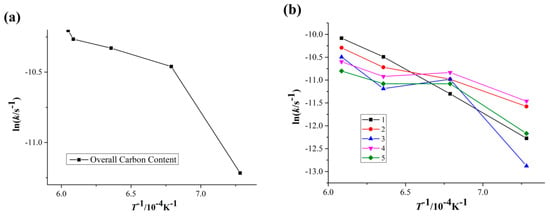
Figure 6.
Relationship between the apparent rate constant and temperature: (a) overall carbon content and (b) carbon contents of different regions.
4.2. Distribution of Carbon
Below 1300 °C, the distribution of carbon is similar to that of the as-debound part (900 °C). In the later stage of sintering, the density of the sintered body exceeds 90%, and the interconnected pores begin to close; hence, the decarburization behaviour should be more similar to that of the dense steel. Carbon atoms must migrate from the inner area to the surface to react with oxygen [19]. The loss of carbon on the outermost surface zone is much more rapid than the replenishment by the solid diffusion of carbon. Hence, a farther distance from the surface corresponds with a higher carbon content. Figure 4 shows that, when the sintering is carried out above 1300 °C, the inner layer exhibits a high carbon content. For a dense steel, the carbon content and the distance to the surface X should obey the following equation [20]:
where C0, Cx, and Cs refer to the carbon content of the initial state (0.38%), cross section with distance to the surface X, and atmosphere (assumed to be zero), respectively; and D is the diffusion coefficient of carbon, which can be calculated by the Arrhenius equation:
where D0 is the diffusion constant and Q is the activation energy of diffusion. From the literature, D0 = 2.0 × 10−5m2/s, and Q = 140 × 103 J/mol [21]. The experimental and simulated carbon content are shown in Figure 7. For samples sintered at 1300 °C, the distribution of carbon is completely different from that of the dense steel or the as-debound part, as shown in Figure 7a. This phenomenon is mainly the result of the lower density of 92%. At this stage, the interconnected pores have been closed for only a short time. There is insufficient time for the carbon atoms to diffuse regularly. When the sintering temperature increases to 1370 °C, the distribution of carbon shows a similar tendency to that of dense steel. However, the centre areas (regions 3−5) show a lower carbon content than those of the simulated results, whereas the surface areas (regions 1 and 2) are the opposite. The lower carbon content in the centre can be attributed to the decarburization at the early stage; some of the carbon has already been removed through the interconnected pores, and thus the second decarburization stage starts with a lower initial carbon content. In the meantime, the residual free carbon in the surface regions may be trapped by the closing of open pores, which requires a longer time to diffuse out and results in a higher carbon content in regions 1 and 2.
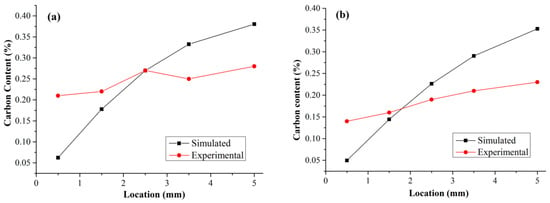
Figure 7.
Experimental and simulated carbon distribution of samples sintered at: (a) 1300 °C and (b) 1370 °C.
4.3. Relationship between Decarburization and Densification
During sintering, the density increases with the sintering temperature. As shown in Figure 5, the sintering neck could be observed at 1100 °C, but significant growth does not take place until 1200 °C. The densification is retarded by the pre-existing surface oxide layers [22]. According to previous research, the growth of sintering necking must break the Fe–O bonds and remove the oxygen to the atmosphere [15]. The existence of carbon could accelerate this process at a proper temperature. At 1200 °C, the centre regions exhibit a higher densification rate than the surface, which may contribute to the fact that the surface particles are covered with a layer of residual carbon. If the carbon content is high enough, the metal particles rarely come into contact with each other, and the growth of sintering necking is prohibited. When the carbon content falls to a lower level, more reduced metal surfaces are exposed and the sintering necking grows. The growth of sintering necking gradually closes the interconnected pores, which is the fast channel for carbon migration. Thus, the decarburization speeds of the centre regions are reduced one by one. Meanwhile, the surface area still exhibits a high decarburization speed. As a result, the carbon content of the centre regions exceeds that of the surface region at 1300 °C. At 1370 °C, the densification process is nearly completed and the sample has a very high relative density; therefore, the carbon can migrate only from the centre to the surface to react with the atmosphere. The carbon content is similar to the dense decarburization part. Obvious decarburization at the surface has a significant harmful effect on the mechanical properties of as-sintered parts, because hardness, strength, fatigue, and wear properties are strongly dependent on the carbon content. The microhardness test can also prove this phenomenon.
5. Conclusions
- The decarburization of MIM-produced 420 stainless steel could be separated into two stages.
- At lower temperatures, decarburization occurs at the powder particle surface. The oxygen in the atmosphere or surface oxides reacts with the carbon. At this time, the carbon content distribution of the sintered body is similar to that of the as-debound sample.
- The reduction of surface oxides promotes sintering. The densification speed is faster in the centre region of samples sintered at 1300 °C, where the interconnected pores are closed.
- At higher temperatures, carbon in the inner layer must migrate to the surface to react with the atmosphere. The decarburization speed is reduced, and the carbon content distribution of the as-sintered part is similar to that of the dense decarburized part.
Author Contributions
Conceptualization, J.L., H.H., and Y.L.; software, M.L.; validation, M.L., C.A., and X.O.; formal analysis, C.A. and J.L.; investigation, X.W.; resources, X.O.; data curation, J.L.; writing—original draft preparation, J.L., M.L., and H.H.; writing—review and editing, H.H., X.W., and J.L.; visualization, X.O.; supervision, X.W., Y.L., and H.H.; project administration, Y.L.; funding acquisition, J.L. and H.H. All authors have read and agreed to the published version of the manuscript.
Funding
This research was funded by National Natural Science Foundation of China, grant number 51804271; Hunan Provincial Natural Science Foundation, grant number 2018JJ3507; and Guangxi Science and Technology Plan Project, grant number AD16380019.
Conflicts of Interest
The authors declare no conflict of interest.
References
- Lou, J.; Li, Y.M.; He, H.; Li, D.Y.; Wang, G.Y.; Feng, J.; Liu, C. Interface development and numerical simulation of powder co-injection moulding. Part. I. Experimental results on the flow behaviour and die filling process. Powder Technol. 2017, 305, 405–410. [Google Scholar] [CrossRef]
- Lou, J.; Li, Y.M.; He, H.; Li, D.Y.; Wang, G.Y.; Feng, J.; Liu, C. Interface development and numerical simulation of powder co-injection moulding. Part II. Numerical simulation and experimental verification. Powder Technol. 2017, 305, 357–363. [Google Scholar] [CrossRef]
- Lou, J.; He, H.; Li, Y.M.; Zhu, C.Q.; Chen, Z.Y.; Liu, C. Effects of high O contents on the microstructure, phase-transformation behaviour, and shape-recovery properties of porous NiTi-based shape-memory alloys. Mater. Des. 2016, 106, 37–44. [Google Scholar] [CrossRef]
- Cesar, M.D.G.M.M.; Mantel, M.J. Effect of the temperature and dew point of the decarburization process on the oxide subscale of a 3% silicon steel. J. Magn. Magn. Mater. 2003, 254, 337–339. [Google Scholar] [CrossRef]
- Wei, J.H.; Zhu, D.P. Mathematical modeling of the argon-oxygen decarburization refining process of stainless steel: Part I. Mathematical model of the process. Metall. Mater. Trans. B 2002, 33, 111–119. [Google Scholar] [CrossRef]
- Boué-Bigne, F. Laser-induced breakdown spectroscopy applications in the steel industry: Rapid analysis of segregation and decarburization. Spectrochim. Acta, Part B. 2008, 63, 1122–1129. [Google Scholar] [CrossRef]
- Hao, X.J.; Yin, W.; Strangwood, M.; Peyton, A.J.; Morris, P.F.; Davis, C.L. Off-line measurement of decarburization of steels using a multifrequency electromagnetic sensor. Scr. Mater. 2008, 58, 1033–1036. [Google Scholar] [CrossRef]
- Auinger, M.; Vogel, A.; Praig, V.G.; Danninger, H.; Rohwerder, M. Thermogravimetry and insitu mass spectrometry at high temperatures compared to thermochemical modelling—The weight loss during selective decarburisation at 800 °C. Corros. Sci. 2014, 78, 188–192. [Google Scholar] [CrossRef]
- Szekely, J.; Asai, S. Decarburization of stainless steel: Part II. A mathematical model and a process optimization for industrial scale systems. Metall. Trans. 1974, 5, 1573–1580. [Google Scholar] [CrossRef]
- Zhao, X.; Song, B.; Zhang, Y.J.; Zhu, X.M.; Wei, Q.S.; Shi, Y.S. Decarburization of stainless steel during selective laser melting and its influence on Young’s modulus, hardness and tensile strength. Mater. Sci. Eng. A. 2015, 647, 58–61. [Google Scholar] [CrossRef]
- Rosa, C.E.F.D.L.; Trejo, M.H.; Román, M.C.; López, E.A. Effect of Decarburization on the Residual Stresses Produced by Shot Peening in Automotive Leaf Springs. J. Mater. Eng. Perform. 2016, 25, 1–8. [Google Scholar]
- Attia, U.M.; Alcock, J.R. A review of micro-powder injection moulding as a microfabrication technique. J. Micromech. Microeng. 2011, 21, 43001–43022. [Google Scholar] [CrossRef]
- Raza, M.R.; Ahmad, F.; Omar, M.A.; German, R.M.; Muhsan, A.S. Defect Analysis of 316LSS during the Powder Injection Moulding Process. Defect Diffus. Forum. 2012, 329, 35–43. [Google Scholar] [CrossRef]
- Do, T.; Chang, S.S.; Stetsko, D.; Vanconant, G.; Vartanian, A.; Pei, S.; Kwon, P. Improving Structural Integrity with Boron-based Additives for 3D Printed 420 Stainless Steel. Procedia Manuf. 2015, 1, 263–272. [Google Scholar] [CrossRef]
- He, H.; Lou, J.; Li, Y.M.; Zhang, H.; Yuan, S.; Zhang, Y.; Wei, X.S. Effects of oxygen contents on sintering mechanism and sintering-neck growth behaviour of Fe Cr powder. Powder Technol. 2018, 329, 12–18. [Google Scholar] [CrossRef]
- Li, X.B.; Qi, T.G.; Peng, Z.H.; Liu, G.H.; Zhou, Q.S. Kinetics of chromite ore in oxidation roasting process. Chin. J. Nonferrous Met. 2010, 20, 1822–1828. [Google Scholar]
- Li, X.G.; Chen, J.; Hao, J.J.; Han, P.D.; Liu, J.Y. Comparative research on solid state decarburization kinetics of high-carbon ferrochrome powder by microwave heating and conventional heating. Chin. J. Nonferrous Met. 2014, 24, 2181–2187. [Google Scholar]
- Chasoglou, D.; Hryha, E.; Norell, M.; Nyborg, L. Characterization of surface oxides on water-atomized steel powder by XPS/AES depth profiling and nano-scale lateral surface analysis. Appl. Surf. Sci. 2013, 268, 496–506. [Google Scholar] [CrossRef]
- Xu, Y.T.; Chen, Z.P.; Zhang, G. Kinetic Model of Decarburization and Denitrogenation in Vacuum Oxygen Decarburization Process for Ferritic Stainless Steel. Metall. Mater. Trans. B. 2009, 40, 345–352. [Google Scholar] [CrossRef]
- Li, D.; Hao, H.; Li, Y.; Jia, L. Inhomogeneous distribution of oxygen in sintered Ti–Nd alloy. Mater. Lett. 2017, 191, 85–88. [Google Scholar] [CrossRef]
- Duan, G. Effect of High Magnetic Field Annealing on Carbon Diffusion Coefficient in Pure Iron. Master’s Thesis, NorthEastern University, Shenyang, China, 28 June 2012. [Google Scholar]
- Lou, J.; Li, Y.M.; He, H.; Li, L.J. Effect of atomisation medium on sintering properties of austenitic stainless steel by eliminating influence of particle shape and particle size. Powder Metall. 2010, 53, 112–117. [Google Scholar] [CrossRef]
© 2020 by the authors. Licensee MDPI, Basel, Switzerland. This article is an open access article distributed under the terms and conditions of the Creative Commons Attribution (CC BY) license (http://creativecommons.org/licenses/by/4.0/).